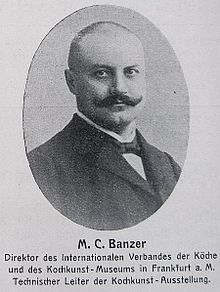Matthaeus Carl Banzer
Matthaeus Carl Banzer (born February 3, 1867 in Marburg ; † September 19, 1945 in Langen ; often MC Banzer , sometimes also Matthäus or Karl , occasionally incorrectly spelled Mätthaus ) was a German hotel clerk, founder of the International Association of Chefs, founder of the culinary art museum , Initiator of the international culinary art exhibition in Frankfurt as well as author and translator of gastronomic non-fiction books.
Act
The hotel clerk Banzer founded the "International Association of Chefs" (IVdK) with others on September 2, 1896 in Frankfurt am Main . First he was association secretary, then until 1933 association chairman. Banzer was also the editor of the newspaper of the chefs , which appeared from November 1896, and, as association director, publisher of the specialist journal Kochkunst (1907–1914 Kochkunst und Tafelwesen , from 1920 Die Küche ).
Banzer was a visionary who at the same time knew how to “inspire others for his ideas and put his visions into practice.” The first International Culinary Art Exhibition (IKA) he initiated at Messe Frankfurt opened on October 12, 1900. Until In 1934 he remained its technical director. The foundation stone was laid on March 5, 1908 and the association house opened on January 19, 1909. There he set up a culinary art museum with a specialist library - the first of its kind in the world - and was its director. The museum's treasures, including an extensive collection of menus and menus, were lost during World War II due to bomb hits and the turmoil of time. In 1917 the Association of German Chefs and the IVdK merged to form the IVdK under his leadership . In 1921, a teaching and research kitchen was added to the association and an auditorium was set up for specialist lectures.
After the seizure of power by the National Socialists, the club on May 2, 1933 " brought into line " and the German Labor Front connected (DAF). The culinary art museum was taken over by the Society for the Promotion of Culinary Art in Frankfurt am Main . It was actually supposed to move to Berlin, but stayed in Frankfurt and spared a shadowy existence. The 1937 culinary arts exhibition was organized by the DAF.
There was no longer any room for an individualist like Balzer. He was adopted in December 1934, awarded a certificate and, from the beginning of 1935, deported to the Honorary Board. He was succeeded by party members Hans Wolkersdörfer as director of the IVdK, which no longer existed as such, and Jean Hardt as curator of the museum.
The work Le guide culinaire by Auguste Escoffier from 1903 set new standards for the professional kitchen. It was translated jointly by Banzer and others as quickly as possible and published as Der Kochkunst-Führer in 1904 . Banzer also published a special index and dictionary for the first and unchanged second German edition. In the fourth edition (the 3rd French) he edited and was responsible for the terminology, the 5th edition (the 4th French) he edited using the earlier editions. (1st German edition 1904 after the 1st French edition; 2nd German edition 1906 after the 1st French edition, unchanged; 3rd German edition approx. 1910 after the 2nd French edition Completely circumscribed and probably; 4th German edition 1914, aut. Translation of the 3rd French edition; 5th German edition 1923 aut. Translation of the 4th French edition; 6th – 15th German edition approx. 1930–1993 aut. Translation of the 5th French edition, translated by W. Bickel using earlier editions.)
After his forced retirement, Banzer was still involved in the publication of the culinary arts library and devoted his life to culinary arts until his death in September 1945.
In 1948 the successor association Association of German Chefs was founded .
Individual evidence
- ↑ a b c d e f g Wolfgang Klötzer (Ed.): Frankfurter Biographie . Personal history lexicon . First volume. A – L (= publications of the Frankfurt Historical Commission . Volume XIX , no. 1 ). Waldemar Kramer, Frankfurt am Main 1994, ISBN 3-7829-0444-3 . P. 38
- ↑ a b c d History , Association for the Promotion of Table Culture, 2009
- ↑ a b c d The art of cooking in Germany - The culinary art museum in Frankfurt / Main , The virtual cookbook museum, version of July 6, 2010
- ↑ The history of a magazine ( page no longer available , search in web archives ) Info: The link was automatically marked as defective. Please check the link according to the instructions and then remove this notice. , Küche, kueche-magazin.de, accessed on September 25, 2010
- ↑ a b c d e Sabine Hock : A worldwide unique cultural institute - association ties in with the history of the Frankfurt Culinary Art Museum, in: Wochendienst, ed. v. Press and Information Office of the City of Frankfurt am Main, No. 40 of October 3, 2000
- ↑ See Walter Schwarz, Das Kochkunstmuseum in Frankfurt am Main , Kramer, Frankfurt am Main 1989, ISBN 3-7829-0387-0
- ↑ About us , Frankfurt Cooks Association, viewed on January 13, 2014
- ^ History ( memento from January 19, 2012 in the Internet Archive ), Association of German Chefs
- ↑ a b The Art of Cooking in Germany - The Kitchen: Contents after 1933 , The Virtual Cookbook Museum, version from July 6, 2010
| personal data | |
|---|---|
| SURNAME | Banzer, Matthaeus Carl |
| ALTERNATIVE NAMES | Banzer, MC; Banzer, Matthäus Carl; Banzer, Matthaeus Karl; Banzer, Mätthaus Carl |
| BRIEF DESCRIPTION | German hotel clerk and author, founder of the International Association of Chefs |
| DATE OF BIRTH | February 3, 1867 |
| PLACE OF BIRTH | Marburg |
| DATE OF DEATH | September 19, 1945 |
| Place of death | Long |

